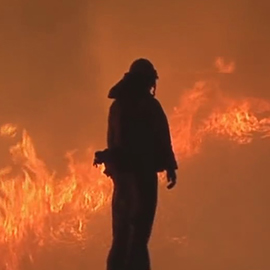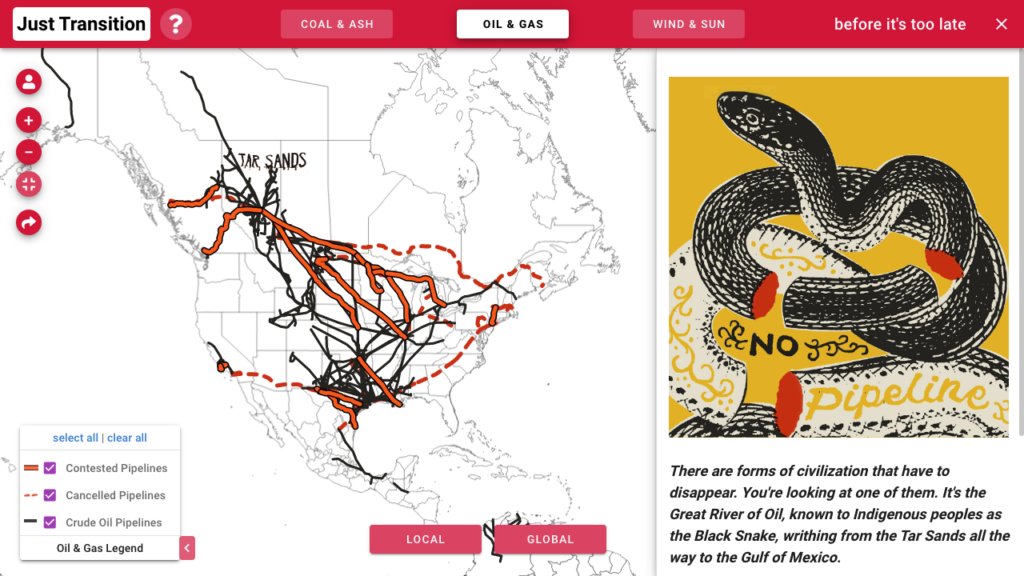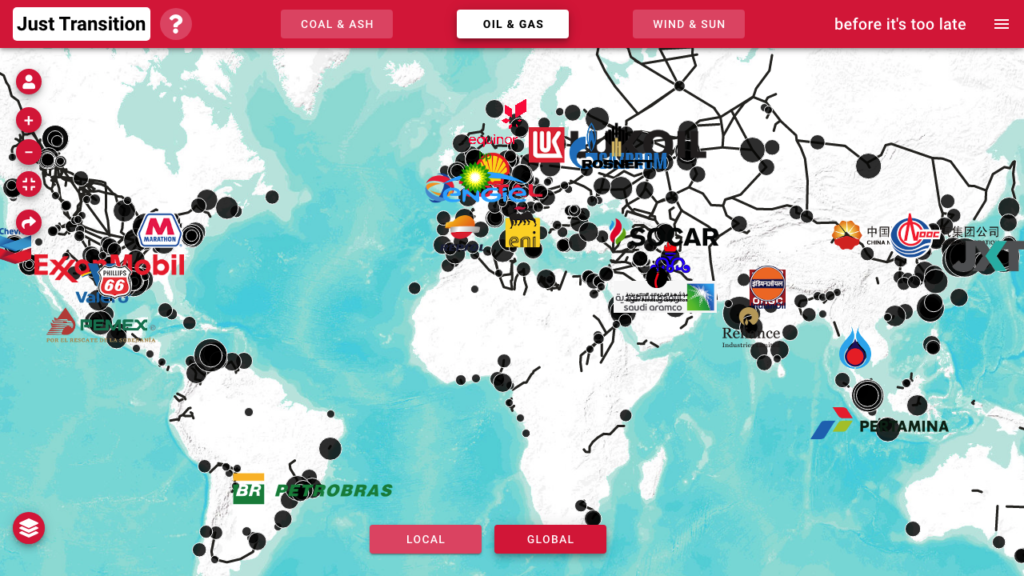
How to break the largest, heaviest, most pervasive and most toxic infrastructure in history, the global fossil fuel system? How to break that system down without shutting off the lights at night and the heat in the winter, without cratering national economies, and more urgently, without sparking a civil war, or even a world war? How to make an entirely new electric power grid in the unbelievably short span of time that remains before planetary ecological collapse? And how to make that highly innovative technical system serve basic human goals of equity and reciprocity, under the grassroots guidance of a democratic politics that keeps Big Oil from simply taking over a new imperial role as Big Energy?
Making and breaking are words that apply to local revolts, artistic creations, philosophical deconstructions, mythical rebirths. But today these words apply to the material world, with its built architecture, its organizational forms, its multispecies inhabitants and its biogeochemical cycles. If we don’t break the existing world order, and if we don’t make it new from the bottom up, then our amazingly prosperous society with all its stunning achievements is going down. And it’s going down a lot quicker than anyone could have imagined, like those supertankers you hear about on the news, stranded on some Caribbean reef, battered by the waves, then suddenly shattering into massive sinking pieces, dispersing their thick and viscous cargo into the once-green sea.
Like everyone else I sat inside for weeks on end during the early phases of the pandemic, feeling vulnerable, feeling alone, staring into my screens. How could I, as a singularly powerless individual, do something that might actually be worth something, even if there is never any guarantee?
We have learned to do nothing – because the problem is too big. I decided I would map the entire global fossil fuel infrastructure, plus the emergent renewable power system that is already beginning to replace it. I would go for it all, the whole world, but I would also focus in on something smaller, more manageable: North America, where I already know enough to get some accurate information. I would build a software system that could handle all that information, and I would make the system editable, so that every pipeline, every power plant, every wind or solar farm could be examined, analyzed and described by the people who live next to it. I would seek out collaborators who believe that knowledge is power, if you act on what you know. I would throw my all into one of the basic responsibilities of the ecological citizen: seeking a just transition from fossil fuels to a sustainable energy system. I would do this singular and potentially crazy thing, because millions of people share that exact same goal.

Rage makes you want to break. Love makes you want to build. Art spawns grandiose delusions that lead straight back to the realities of the material world. In the course of six months, I’ve taken some first steps in a project of making and breaking, and found quite a few collaborators along the way. The aim is to show a reality, to symbolize a possibility, and to open that double process up to a collectivity.
Has this project achieved its goals? Six months is not even time enough to begin! So far we have done nothing more than to sketch out the work, but also the dream, of the make-or-break generation of the present. For some of us, the pandemic has brought immensely valuable time to feel and to think. Vulnerable individuals have begun to ask what it means, in the most pragmatic and material terms, to care for threatened lives on planet earth.
The website from which this text is borrowed forms the other side of the online map, Time To Change / Just Transition. Together, map and website form a geographic information system. Its aim is to provide swift and trustworthy access to geolocated knowledge about the North American energy landscape. Publicly available data, compiled by government agencies and civil-society organizations, has been collated into three thematic sections, covering the oil & gas industry, coal and its devastating environmental consequences, and emergent electric power production based on renewables.

A GLOBAL button located at the bottom center of the screen allows you to place the North American energy system in a broader context (though for now, the information is less precise at global scale). More importantly, a LOCAL button lets you examine the energy landscape in your own geographical area. Some analytics have been added to the sidebar information display. Advanced editing tools have been developed to allow trusted groups and individuals to correct errors and add features. We are actively seeking partnerships for the elaboration of localized knowledge.
Conceived and launched during the Covid-19 pandemic, the project recognizes two urgent timelines. The first one is obvious: It’s the warning issued in 2018 by the Intergovernmental Panel on Climate Change. The IPCC scientists call for a reduction of CO2 emissions by 45% below 2010 levels *before 2030*. Beyond that fast-approaching date, they call for a drawdown to net-zero emissions by 2050, in order to avoid the devastating consequences already revealed by intensifying droughts, wildfires and hurricanes.1 If you consider the complexity of the current energy system, and above all, the many resistances to leaving it behind, then you may agree that the active input of a well-informed and determined citizenry will be absolutely crucial to meeting these IPCC deadlines.
Our second timeline is shorter and far less widely understood, although it’s crystal clear in the eyes of economists and national-level officials. They proclaim that over the next two to five years, governments will need to spend their way out of the global depression provoked by Covid-19. What’s more, the governments that make this choice will need to direct the money toward gainful employment at all levels, to produce the multiplier effects of shared prosperity that stable employment brings. The proponents of a Green Recovery2 or a Green New Deal3 see the creation of a carbon-zero energy system as a golden opportunity to overcome the Covid depression, while staving off the most devastating consequences of extreme climate chaos.
Of course, there is no done deal. To distract from the mounting dangers of ecological collapse, politicians could choose to stoke internal divisions, imagine outside enemies, build walls against “foreign invaders,” and then, almost inevitably, start wars. Does this resemble any number of elephants in the room?
So, look at it this way: if we all had ten years until ecological disaster, and if governments had trillions to spend tomorrow, what exactly would *you* do?

We advocate for a Green Recovery/Green New Deal, and believe that collaborative information and communication infrastructure can help facilitate citizen oversight and grassroots guidance of government programs. Our aim is to contribute to what labor organizations and front-line communities across North America are calling for, namely a Just Transition.4 This is a program of civilizational change, where the technological move away from fossil fuels becomes a political pathway toward meaningful employment, comprehensive social services and a healthy environment for everyone. We believe that these benefits cannot simply be provided from on high, but instead must be actively co-produced by all communities, regardless of race, ethnicity, geography or current economic status. A corporate greenwashing recovery would amount to nothing more than a switch from Big Oil to Big Energy. Only a Just Transition can achieve social peace, substantial equity, and the crucial missing factor of universally shared respect for racial, cultural, sexual and individual difference.
So what do you think? Are we just dreaming? In the realm of energy production, “citizen oversight” has so far consisted of scathing but ineffective critique, while “grassroots guidance” has taken the controversial forms of massive popular protest and non-violent direct action against new fossil-fuel infrastructure. We too are scathingly critical. We too believe in the power of popular protest. Yet as alternative generating facilities come on line, as energy consumption plummets under pandemic conditions, as worthless pipeline projects are withdrawn in the face of legal and economic challenges, as failing shale-oil companies explode the myth of “unconventional” energy production, and as the oil majors lose their formerly privileged positions on national and international economic scorecards, we believe that a new era may be dawning. To get to the light of day, the rising sun of social and ecological recovery is going to need a serious push from the people at the bottom.
Do you know where your power comes from? It may come from a detailed knowledge of how energy is actually generated under current conditions, and from an expansive vision of how it could be and is already being generated differently. It may come from the conviction that knowledge does matter, when it’s directly connected to action.
Feel free to use and improve this map, and to share and expand the aspirations that underlie it. The generation of power for civilizational change is a process that can involve everyone, at every scale of critical awareness and constructive activity.

